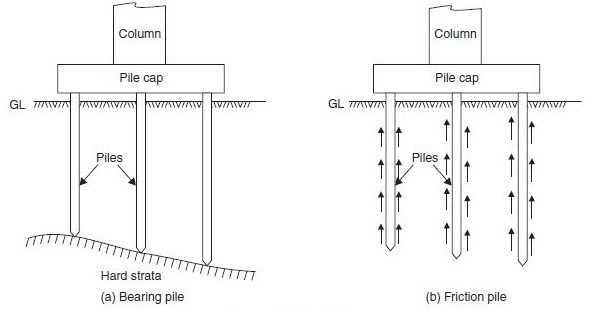There are four types of pile foundations according to their construction methods which are driven piles, cast-in-situ piles, and driven and cast-in-situ piles.
- Timber Piles
- Concrete Piles
- Steel Piles
- Composite Piles
Primarily piles can be classified into two parts. Displacement piles and Non-displacement or Replacement piles. Piles which causes the soil to be displaced vertically and radially as they are driven to the ground is known as Displacement piles.
In case of Replacement piles, the ground is bored and the soil is removed and then the resulting hole is either filled with concrete or a pre-cast concrete pile is inserted.
Types of Pile Foundations Based on Construction Method
On the basis of materials of pile construction and their installation process load-bearing piles can be classified as follows:
- Timber Piles
- Untreated
- Treated with Preservative
- Concrete Piles
- Pre-cast Piles
- Cast-in-place Piles
- Steel Piles
- I-Section Piles
- Hollow Piles
- Composite Piles
- Concrete and Steel
- Concrete and Timber
Timber Piles
Timber piles are placed under the water level. They last for approximately about 30 years. They can be rectangular or circular in shape. Their diameter or size can vary from 12 to 16 inches. The length of the pile is usually 20 times of the top width.
They are usually designed for 15 to 20 tons. Additional strength can be obtained by bolting fish plates to the side of the piles.

Advantages of Timber Piles-
- Timber piles of regular size are available.
- Economical.
- Easy to install.
- Low possibility of damage.
- Timber piles can be cut off at any desired length after they are installed.
- If necessary, timber piles can be easily pulled out.
Disadvantages of Timber Piles-
- Piles of longer lengths are not always available.
- It is difficult to obtain straight piles if the length is short.
- It is difficult to drive the pile if the soil strata are very hard.
- Spicing of timber pile is difficult.
- Timber or wooden piles are not suitable to be used as end-bearing piles.
- For durability of timber piles, special measures have to be taken. For example- wooden piles are often treated with preservative.
Concrete Piles
Pre-cast Concrete Pile
The precast concrete pile is cast in pile bed in the horizontal form if they are rectangular in shape. Usually, circular piles are cast in vertical forms. Precast piles are usually reinforced with steel to prevent breakage during its mobilization from casting bed to the location of the foundation. After the piles are cast, curing has to be performed as per specification. Generally curing period for pre-cast piles is 21 to 28 days.
Advantages of Pre-cast Piles
- Provides high resistance to chemical and biological cracks.
- They are usually of high strength.
- To facilitate driving, a pipe may be installed along the center of the pile.
- If the piles are cast and ready to be driven before the installation phase is due, it can increase the pace of work.
- The confinement of the reinforcement can be ensured.
- Quality of the pile can be controlled.
- f any fault is identified, it can be replaced before driving.
- Pre-cast piles can be driven under the water.
- The piles can be loaded immediately after it is driven up to the required length.
Disadvantages of Pre-cast Piles
- Once the length of the pile is decided, it is difficult to increase or decrease the length of the pile afterward.
- They are difficult to mobilize.
- Needs heavy and expensive equipment to drive.
- As they are not available for readymade purchase, it can cause a delay in the project.
- There is a possibility of breakage or damage during handling and driving od piles.
Cast-in-Palace Concrete Piles
This type of pile is constructed by boring of soil up to the desired depth and then, depositing freshly mixed concrete in that place and letting it cure there. This type of pile is constructed either by driving a metallic shell to the ground and filling it with concrete and leave the shell with the concrete or the shell is pulled out while concrete is poured.
Advantages of Cast-in-Place Concrete Piles
- The shells are light weighted, so they are easy to handle.
- Length of piles can be varied easily.
- The shells may be assembled at sight.
- No excess enforcement is required only to prevent damage from handling.
- No possibility of breaking during installation.
- Additional piles can be provided easily if required.
Disadvantages of Cast-in-Place Concrete Piles
- Installation requires careful supervision and quality control.
- Needs sufficient place on site for storage of the materials used for construction.
- It is difficult to construct cast in situ piles where the underground water flow is heavy.
- Bottom of the pile may not be symmetrical.
- If the pile is un-reinforced and uncased, the pile can fail in tension if there acts and uplifting force.
Steel Piles
Steel piles may be of I-section or hollow pipe. They are filled with concrete. The size may vary from 10 inches to 24 inches in diameter and thickness is usually ¾ inches. Because of the small sectional area, the piles are easy to drive. They are mostly used as end-bearing piles.
Advantages of Steel Piles
- They are easy to install.
- They can reach a greater depth comparing to any other type of pile.
- Can penetrate through the hard layer of soil due to the less cross-sectional area.
- It is easy to splice steel piles
- Can carry heavy loads.
Disadvantage of Steel Piles
- Prone to corrosion.
- Has a possibility of deviating while driving.
- Comparatively expensive.
Check out the rest part of types of pile foundations other than Types of Pile Foundations Based on Construction Method.